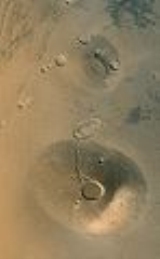
Ceraunius Tholus
Encyclopedia

Mars
Mars is the fourth planet from the Sun in the Solar System. The planet is named after the Roman god of war, Mars. It is often described as the "Red Planet", as the iron oxide prevalent on its surface gives it a reddish appearance...
located in the Tharsis quadrangle at 24.2 degrees north latitude and 97.4 degrees west longitude and it is a part of Uranius group of volcanoes
Uranius group of volcanoes
The Uranius group of volcanoes is located on planet Mars in the northeast part of Tharsis and include Uranius Patera, Ceraunius Tholus, and Uranius Tholus. They are dated to the Late Hesperian Epoch and are part of earliest phases of volcanism in the Tharsis province. All three volcanoes are...
. It is 130 km across, 5.5 km high and is named after a classical albedo
Albedo
Albedo , or reflection coefficient, is the diffuse reflectivity or reflecting power of a surface. It is defined as the ratio of reflected radiation from the surface to incident radiation upon it...
feature name.
It is generally believed to be a basaltic shield with the lower part buried beneath plain forming lavas. Earlier interpretations suggested that it is a stratovolcano
Stratovolcano
A stratovolcano, also known as a composite volcano, is a tall, conical volcano built up by many layers of hardened lava, tephra, pumice, and volcanic ash. Unlike shield volcanoes, stratovolcanoes are characterized by a steep profile and periodic, explosive eruptions...
. The slopes on Ceraunius Tholus are quite steep with an average slope of 8° with many radial erosion channels and pitted valleys extending from just below the rim of the caldera
Caldera
A caldera is a cauldron-like volcanic feature usually formed by the collapse of land following a volcanic eruption, such as the one at Yellowstone National Park in the US. They are sometimes confused with volcanic craters...
toward the base of the volcano. The current view is that the valleys were eroded by water. Interesting features on Ceraunius Tholus are three large canyons at the northwest flank of Ceraunius Tholus which are up to 2.5 km wide and 300 m deep. The biggest of these three also appears to be the youngest and protrude from the lowest point of the volcanic caldera and ends at the interesting Rahe crater (an oblique impact crater with measures of 35 × 18 km), just north from the volcano where it formed a depositional fan. Its origin is still debatable and there are four main models proposed: fluvial action, volcanic flows, valley being a lava channel or some combination of previously mentioned models.
The caldera of Ceranius Tholus is also dotted with many collapse pits which are distinct from impact craters as the have no rim and vary in concentration across caldera.
Ceraunius Tholus is probably late Hesperian in age.
Glaciers
Some scientists believe that glaciers exist on many of the volcanoes in Tharsis including Olympus Mons, Ascraeus Mons, and Pavonis Mons. Ceraunius Tholus may have even had its glaciers melt to form some temporary lakes in the past. The shape of the Ceraunius Tholus caldera suggests that in the past meltwater would also accumulate in a caldera lake.Environment around Ceraunius Tholus
Ceraunius Tholus is on the Tharsis rise, also called the Tharsis bulge. Tharsis is a land of great volcanoes. Olympus MonsOlympus Mons
Olympus Mons is a large volcanic mountain on the planet Mars. At a height of almost , it is one of the tallest mountains in the Solar System, three times as tall as Mount Everest and more than twice the height of Mauna Kea the tallest mountain on Earth. Olympus Mons is the youngest of the large...
is the tallest known volcano. Ascraeus Mons
Ascraeus Mons
Ascraeus Mons is a large shield volcano located in the Tharsis region of the planet Mars. It is the northernmost and tallest of three shield volcanoes collectively known as the Tharsis Montes. The volcano's location corresponds to the classical albedo feature Ascraeus Lacus.Ascraeus Mons was...
and Pavonis Mons
Pavonis Mons
Pavonis Mons is a large shield volcano located in the Tharsis region of the planet Mars. It is the middle member of a chain of three volcanic mountains that straddle the Martian equator between longitudes 235°E and 259°E. The volcano was discovered by the Mariner 9 spacecraft in 1971 and was...
are at least 320 km across and are over 10 km above the plateau
Plateau
In geology and earth science, a plateau , also called a high plain or tableland, is an area of highland, usually consisting of relatively flat terrain. A highly eroded plateau is called a dissected plateau...
that they sit on. Then, the plateau is five to four seven kilometers above the zero altitude of Mars.

